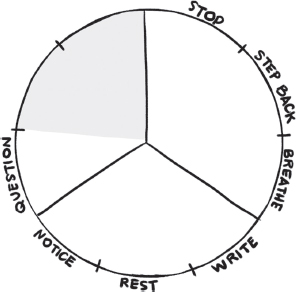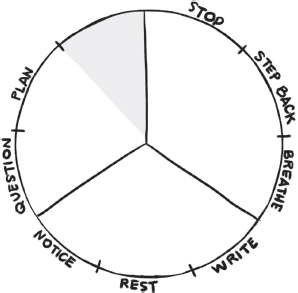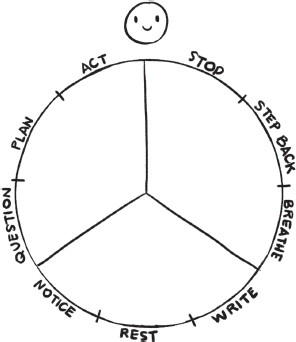Chapter 10
Phase 3: Refocus
Another high-five coming your way! By now you should feel like you have the tools and strategies to switch off when you need to. You should know how to take a step back when required and how to create the space to think and rest.
In phase 3 of switching off we flick the switch. We can't always be in a zoned-out, disconnected, chilled-out rest zone. Now it's time to draw on the perspective and energy we have gained through taking time out and to plug it in where it's needed. But before we get too excited let's take the opportunity to shift our focus to how we are going to do things from this point forward. We were brave enough to stop, we were willing to open ourselves to noticing what is happening within and around us, and we learned how to surrender ourselves to being well rested. Now is the time for us to ask, ‘Knowing what we know, what are we going to do about it?'
To be effective we need to know how to flick the switch.
Generally, this sort of reflection is dismissed as a waste of time. We hear the saying, ‘The past is past, the future is in the future. What matters is the here and now'. And this is right … in a way. But if we don't take the time to look back at our experiences and learn from them, we will often keep on repeating patterns of behaviour that do not serve us well. When we focus solely on moving forward we don't take the time to identify these patterns and make the changes needed. This final phase is about refocusing and bringing into our lives the energy to spur us to do what we need to do. To be effective we need to know how to flick the switch. When we can do this, we start to regain control. But first we must be honest with ourselves about what we want.
Question

Remember when we looked at the continuum of choice back in chapter 7? In stage 5 we explored the importance of reflecting on decisions made. This stage is important in breaking negative cycles of decision making and facilitating opportunities for great decision making.
Moving into this phase you need to ask yourself key reflective questions about how you have been doing things in your life, so you can make the best possible choices about when and how to switch off from this point forward. You don't want to wait until you are sick or exhausted to switch off; you want to be in control of when you take time out and how you use your energy and focus. If you really want to embrace the lifestyle that comes with being able to flick the switch when you need to, first take the time to look at why this lifestyle matters to you and how the benefits of living a life of being in control will allow you to do the things you love with the people you enjoy being around.
If you don't yet feel ready to answer these questions and are just flicking through the book for valuable information, it would be a great idea to flag this page; put a sticky note on it or insert a bookmark so you can come back to it when you are ready. Don't wait too long though, because your answers to these five key questions are what will move you into feeling calm and in control.
As already noted, the process of switching off is determined by personal variables. When answering these five questions take notice of how you are feeling, particularly when responding to number 4, ‘What difference will the ability to control when you switch off make in your life?' The feeling you get will tell you a lot about how important it is to make these changes in your life now.
Plan

Armed with the strategies and skills to switch off when needed, it is time to refocus on how you are going to integrate this knowledge into your daily life. Switching off from work, life and people is a process. Incorporating the skills in your life takes practice, and it becomes easier when you have a plan.
Without a plan or map we are feeling our way blindly, which means we rely on luck, past experience and other people to show us the way.
Throughout this book we have talked about the importance of the simple daily habits we create and the profound impact they can have on our sense of being in control of our lives. Without a plan or map we are feeling our way blindly, which means we rely on luck, past experience and other people to show us the way. Taking the time to create a map of how we want our lives to look, the direction we want to head in and what targets we want to meet — that is, what we want to do in life — will significantly increase our ability to achieve these goals. It doesn't mean we'll always achieve them, but with a plan we can start to make choices based on where we would like to go.
Plans can be as specific or as loose as you like. Whatever you choose, draw from what you have learned through the phases of switching off, taking into account your financial, personal, health, family and relationship, and work plans. Your plan will mean more than setting aspirational goals as it draws on the lessons you have learned through switching off and creating the space to think, create and reflect.
In the final chapters of this book we will work through a map of how to create a habitat for health in your life. I'll also introduce some tools to help you build the energy and drive you need to fulfil your goals and live the life you choose.
Act

This needs the shortest explanation of all phases of switching off, yet like the first phase, Stop, it is hard to do. It is the habits you implement each and every day that will make the difference when it comes to effectively creating the energy and space needed to switch off and then flick the switch. The hardest part is having the willpower to turn off the television and go to bed earlier, or to get up a little earlier to practise meditation or to create the space to practise breathing more effectively.
As Charles Duhigg explains in his book The Power of Habit, 90 per cent of our actions are habitual. Create daily habits that serve you well and motivate you. Rather than trying to overhaul your whole life or change ten things at once, start with one action and focus on that until it becomes a part of your day. Once the practice becomes a habit, add another. Overcommitment, trying to make too many changes at once, sets us up to fail. It is all too hard. We become overwhelmed and revert to our old, familiar habits … and so the cycle continues. Just choose one thing that will make the biggest difference for you and go from there. We don't want to make change any harder than it has to be!
Create daily habits that serve you well and motivate you.
It's time to discard old habits that have not been serving you well, that have led to your feeling overconnected, overwhelmed and overstimulated, and to start to make choices and develop habits that give you the ability to flick the switch when you need to.